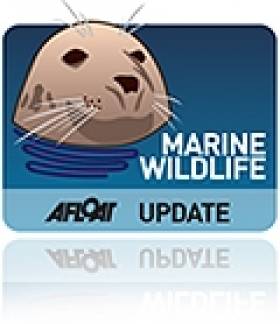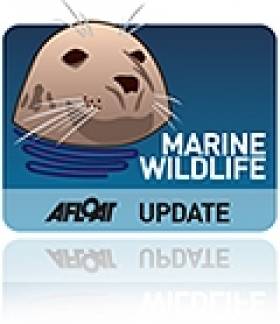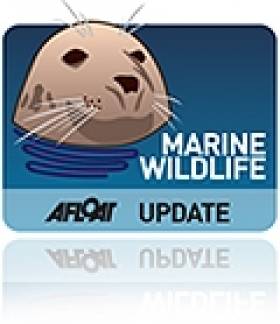Displaying items by tag: Dolphin
Dolphin Rescued in Co Wexford
#MARINE WILDLIFE - A stranded dolphin was rescued at Duncannon on Monday last week, the New Ross Standard reports.
After being spotted by a member of Fethard-on-Sea RNLI, the dolphin was aided by the lifeboat crew, with advice from the Irish Whale and Dolphin Group.
The juvenile dolphin, who appeared to show no distress from the incident, was taken out to see and released in deep water off Templetown strand.
A spokesperson for Fethard-on-Sea RNLI said the crew were "'especially pleased to have undertaken such a rescue mission with a successful outcome".
Concerns Over Seal Deaths in Donegal
Seven dead seals washed up in Donegal are believed to have died of natural causes - but concerns over a pattern of seal deaths nationwide remain.
As the Donegal Democrat reports, the seven grey seals - which are a protected species - were found beached along with a dead dolphin in the Rosberg area.
A ranger with the National Parks and Wildlife Service confirmed that none of the marine animals had been shot.
But Pauline Beades of the Irish Seal Sanctuary said the find was just one in a series of reports of "strange" seal deaths around the country.
“You don’t find three, four, five animals dead on a beach," she said. "I would be very concerned that this is not a normal occurrence.”
It is not yet known if a post-mortem will be carried out in the dead seals, but members of the public are encouraged to report any similar finds as the thocine distemper virus has been responsible for seal deaths in the past.
Beades said that grey seals are now having their young, and asked the public to keep an eye out for seal pups and report anything that looks suspicious in the area.
The Donegal Democrat has more on the story HERE.
Marine Department Promised, First America's Cup Capsize, Whales and Sailing Oil Tankers
I am reflecting this week on a varied list of maritime issues which have arisen in my writings on marine topics.
Following recent pieces I wrote about the attitude of political parties in the General Election towards the marine sector, I had a telephone call from a senior Fine Gael politician and, lo and behold, the party included the marine sector in its manifesto, pledging to restore the Department of the Marine, abolished by Fianna Fail. I await post-election developments with interest.
It has been a good week for those interested in protection of whales and dolphins. Hundreds of dolphins were spotted off the Old Head of Kinsale, apparently following shoals of herring and sprat on which they were feeding.
In the Antarctic the Japanese whaling fleet was forced to give in to pressure to stop culling. The Japanese have killed hundreds of whales every year, claiming this was for "scientific purposes," even though it has been identified worldwide as for human consumption. The fleet was ordered home by its Government after increasing international pressure.
The Irish Whale and Dolphin Group published its annual report this week. It was formed in December 1990, dedicated to the "conservation and better understanding" of cetaceans - whales, dolphins and porpoise - in Irish waters through "study, education and interpretation." IWDG turnover in 2010 was around €300,000. It has dealt with up to 10,000 queries a month for information on its website. A total of 92 strandings of 128 individual cetaceans was reported to the IWDG in 2010. This compares to 137 strandings of 169 animals for 2009.
This week oil prices rose because of the unrest in Libya and David Surplus, Chairman of B9 Energy Britain's largest windfarm operator, warned that sooner or later oil will run out. BP is examining the possibility of building a fleet of carbon-neutral, wind-powered sail ships planned, to carry world trade.
On the international sailing scene the new AC 45, forerunner of the next generation of America's Cup boats was launched in New Zealand and had its first capsize. The wing-sailed catamaran is designed for speed and close racing, capable of making up to 30 knots, while intended to be handled in tight, tactical courses. An exciting boat to sail, it will also be very testing of ability. The first capsize of the new boat occurred on Auckland's Hauraki Gulf, hit by what was described as "a freak gust of wind," while the crew were doing maintenance on board before a sailing test.

Back in dock after the capsize
It capsized fully, ending upside down. Three support vessels were needed to pick up the crew and right the boat which was sailed back to its base in Auckland. There was damage to the wing sail, but no injuries to the crew. However, helmets may be an additional precaution needed for sailing these boats, which are to be used in the AC World Series! This will be a circuit of eight regattas for which venue bids are being made at present, with fleet and match racing, to raise the profile of high-performance sailing on worldwide television. Racing is to start in July, with regattas running until May of next year, leading into preparations for the next full AC series in the bigger AC72 catamarans in 2013 in San Francisco.
As the past week showed, there is always something interesting in the sea.
This article is reprinted by permission of the EVENING ECHO newspaper, Cork, where Tom MacSweeney writes maritime columns twice weekly. Evening Echo website: www.eecho.ie
Newborn Bottlenose Dolphin Beaches in Co Clare
The Irish Whale and Dolphin Group (IWDG) reports that a newborn bottlenose dolphin calf was washed up in Doolin, Co Clare last week (photos here).
Measuring 1.2m in length and weighing 21kg, the IWDG said it was "by far the smallest bottlenose dolphin recorded stranded in Ireland".
"From the bent dorsal fin and curled tail flukes we can confidently say this dolphin was only just born and live-stranded," said IWDG co-ordinator Simon Berrow, who added that the group could only speculate as to what happened.
"Maybe it was separated from its mother on birth, maybe she was unable to help it to the surface to take its first breath, maybe the mother was alone and did not have the support of a maternal group to assist at birth."
Dead Dolphin in Youghal Prompts Vigilance
Following the discovery of a dead dolphin in Youghal last week, the Irish Whale and Dolphin Group (IWDG) has called on locals to be watchful for marine mammals in distress.
The common dolphin was found washed up on Clay Castle beach last Wednesday 29 September. The species is a frequent visitor to Youghal, and has even been seen upstream in the river Blackwater.
If anyone in the Youghal area comes across a dead or live stranded dolphin, they are urged to contact their area IWDG members Paradig Wholley (Tel: 023 8838761) or Janet Howley (Tel: 086 3977160) or visit www.iwdg.ie.
Live Dolphin Strandings on West Coast
The Irish Whale and Dolphin Group (IWDG) have received reports of five live stranding incidents of these marine animals along the west coast between 23 July and 9 August. There was a further report of a stranded striped dolphin from the Shannon Estuary Co. Clare on 9 August which, although dead when found, may also have live stranded. Pictures on the IWDG Website HERE.
Welcome to Afloat TV

Since 2003 the team behind Afloat magazine has also been producing high-end, internationally appealing and entertaining factual documentaries on the Irish waterways. The production team are a mix of creative, technical and business people whose expertise guarantees an innovative approach to production and a high-quality finished product. The focus is on marine based programmes which entertain and educate. The work has been broadcast on RTE One and internationally on Sky Channels.
The Bay
Screened on RTE One in 2005.
Take a trip around the one half of Ireland's capital city you probably know the least. A new four-part documentary series, The Bay will be screened over four consecutive Wednesdays in May. Using spectacular aerial and underwater footage, the series features a combination of personality-led interviews and themes to tell the story of Dublin's unique waterway. Dublin Bay stretches over six kilometres, from Howth Head on its northern tip to Dalkey Island in the south. It's a place most Dubliners simply take for granted, and one of the capital's least visited places. But there's more going on out there than you'd imagine. And that's why The Bay was made. The series introduces viewers to the rich diversity of activities and personalities around the bay, while also touching on the serious environmental and political issues facing it. Find out more about the bay here.
The Harbour
Screened on RTE One in 2007.
It’s one of the largest natural harbours in the world – and those living near Cork Harbour insist that it’s also one of the most interesting. This was the last port of call for the most famous liner in history, the Titanic, but it has been transformed into a centre for chemical and pharmaceutical industry. Giraffe wander along its shores, from which tens of thousands of men and women left Ireland, most of them never to return. The harbour is home to the oldest yacht club in the world, and to the Irish Navy. This deep waterway has also become a vital cog in the Irish economy. ‘The Harbour’ is not a history programme, nor is it a news focus. It’s simply an exploration of this famous waterway, its colour and its characters. Find out more about the harbour here.
The Estuary
Screened on RTE One in 2007.
The story of the Shannon estuary might well be one of neglect, except that against the odds this waterway has become one of Ireland's greatest natural resources. Windswept, sitting on the edge of the Atlantic, often ignored by the nation. The story of the Shannon estuary might well be one of neglect, except that against the odds this waterway has become one of Ireland's greatest natural resources. A new four-part documentary series, from the makers of RTÉ's The Bay and The Harbour series, uncovers the secrets of the Shannon Estuary. From flying boats to film-making, wildlife to wind-farms, the series reveals how a 100km-stretch of the Shannon waterway has become a hotbed for innovation in Ireland. Up to 40% of Irish energy needs are met here, on the shores of a waterway that is also home to Ireland's second largest airport, a 10,000 student university and a massive cargo port. Ireland - and the world - has learned from the estuary. The first duty free shop was opened here, along with the first industrial free zone. Over the years, thousands of business and political leaders from across the globe have come to Shannon to discover its secret - in the hope that they might copy it. Long before Ireland heard of green energy, this place was producing it. Listen in to dolphin conversations beneath the Shannon's waterline. Uncover the mystery of the Ark, the church on wheels built by a priest who prayed when the tide went out. Narrated by Brenda Fricker, the series aired on Friday nights at 7.30pm on RTÉ One from May 4th 2007. Find out more about the estuary here.
The Navy
Screened on RTE One in 2007.
60 years of the Irish Naval Service. Celebrating the 60th anniversary of the Irish Naval Service, this 3 x half-long feature documentary shows how the Service has evolved into a multi-tasking, multi-disciplinary force. Most Irish people rarely come into contact with the Naval Service, and so are unaware of the range of activities it undertakes. This documentary provides an ideal opportunity to reveal the full extent of the Service’s duties – and the commitment of those who serve on Ireland’s fleet.
The Regattas
Screened on RTE One, 2007 and Sky Sports in 2009.
Sailing featured in RTE’s Christmas schedules this year, with the broadcast of a half-hour documentary feature on the Volvo Dun Laoghaire Regatta 2007. The production, entitled ‘The Regatta’, was shot over four days in Dublin Bay during this year’s regatta. Made by Baily Films, the company behind earlier critically-acclaimed water-based documentaries The Bay, The Harbour, The Estuary and The Navy, it features spectacular on-board footage from a range of craft competing in the event. The Regatta takes viewers both on board the competing craft, and behind the scenes, to examine the challenges thrown up by organising such a large-scale event on the bay. The Regatta was broadcast on RTE 1 on Saturday, December 22, at 4.20pm.
IN DEVELOPMENT
Afloat TV projects at an advanced stage of development include:
The Edge of Ireland
Ireland’s attitude to the seas that surround her is one of the most curious in the world. An island nation, with more coastline than most other European nations, most of her citizens look inland.
Yet no-one in Ireland lives further than 100 kilometres from the sea, and the majority of the population are housed within 10 kilometres of the coast.
More than any other European nation, our history is written on our shores. The very first settlers clung to it, fearing to explore inland. The shores fed and sustained them, and continued to sustain communities from Malin Head to Mizen Head for the next 9,000 years.
From the fort of Dun Aengus to the fields at Carnsore Point, from Inishvickillane to Bull Island, the coastline holds a key to our understanding of Ireland and ourselves.
The Edge of Ireland will uncover that hidden history of Ireland, and explore what the future holds for our coastline. Travelling around the coast, it will use local and national experts to relate individual accounts of how the sea has connected with the land to shape a local community or the nation at large.
The six half-hour series will be presented thematically, rather than using a linear journey up and down the coastline.
CONTACT
If you're keen on promoting Ireland's waterways and would like to get involved with Afloat TV please email us here.

































































